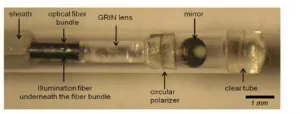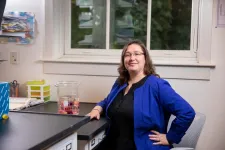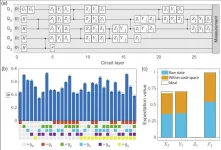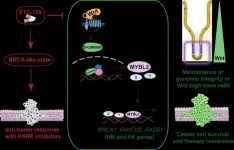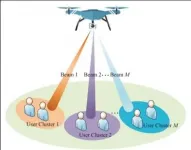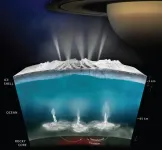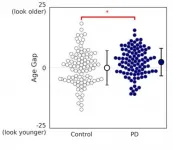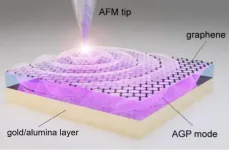(Press-News.org) WASHINGTON -- Researchers have developed a new intravascular imaging technique that could one day be used to detect coronary plaques that are likely to lead to a heart attack. Heart attacks are often triggered when an unstable plaque ruptures and then blocks a major artery that carries blood and oxygen to the heart.
"If unstable coronary plaques could be detected before they rupture, pharmacological or other treatments could be initiated early to prevent heart attacks and save lives," said research team leader Seemantini Nadkarni from the Wellman Center for Photomedicine at Massachusetts General Hospital. "Our new imaging technique represents a major step toward achieving this."
In The Optical Society (OSA) journal Biomedical Optics Express, the researchers report a preclinical demonstration of their new intravascular laser speckle imaging (ILSI) technique in a living animal model. They show, for the first time, that ILSI can identify the distinct mechanical features of plaques that are most likely to rupture under physiological conditions of cardiac motion, blood flow and breathing.
"Reducing mortality from heart attacks in the general population requires a comprehensive screening strategy to identify at-risk patients and detect high-risk vulnerable plaques while they can be treated," said Nadkarni. "By providing the unique capability to measure mechanical stability -- a critical metric in detecting unstable plaques -- ILSI is poised to provide a new approach for coronary assessment."
Capturing mechanical stability of plaques
Although intravascular technologies have been developed to evaluate microstructural features of unstable plaques, recent studies have shown that mechanical features, in addition to microstructural and compositional features, influence plaque rupture.
"Measurement of the plaque mechanical properties is crucial in identifying unstable plaques with a propensity for rupture and subsequent heart attack," said Nadkarni. "ILSI provides the unique capability to quantify an index of mechanical properties of coronary plaques, thus providing a direct assessment of mechanical stability."
To estimate mechanical properties, ILSI uses laser speckle patterns that are formed when laser light is scattered from tissue. When viewed with a high-speed camera, the speckles fluctuate in time due to the viscoelastic properties of the plaque. This allows the researchers to measure and discriminate the mechanical properties of unstable plaques, which tend to be rich in lipids.
"For this new study, we developed a small diameter intravascular catheter that incorporates an optical fiber that delivers light to the coronary artery wall," said Nadkarni. "We also used a small-diameter fiber bundle, polarizer and GRIN lens to image the reflected speckle patterns onto a CMOS sensor."
For preclinical testing, the researchers evaluated the ability of their ILSI instrument to detect unstable plaques in a human coronary to swine xenograft model. This model system uses human coronary arteries that are sutured onto the beating heart of an anesthetized living pig. They assessed the mechanical properties of plaque inside the arteries by calculating the rate, or time constant, of fluctuations in the intensity of the speckle pattern and then compared their results with histopathological findings.
"The time constants in unstable plaques were significantly and distinctly lower than other stable plaques in the coronary wall," said Nadkarni. "These results demonstrated the exquisite diagnostic sensitivity and specificity of ILSI for detecting human lipid pool plaques that were most likely to rupture under physiological conditions."
The researchers say that the new technique could be easily integrated with other intracoronary technologies such as optical coherence tomography or intravascular ultrasound to combine the mechanical findings from ILSI with morphological information to improve the evaluation of plaque stability.
The researchers plan to continue to evaluate the capability of their ILSI instrument for rapid assessment of the coronary vasculature in live animals. Once these preclinical studies are complete, they will assess the safety of the catheter for use in humans and then begin the process of gaining regulatory approval for clinical use.
INFORMATION:
Paper: Z. Hajjarian, J. D. Toussaint, J. L. Guerrero, S. K. Nadkarni, "In-vivo mechanical characterization of coronary atherosclerotic plaques in living swine using intravascular laser speckle imaging," Biomed. Opt. Express, volume 12, issue 4, pp. 2064-2078 (2021).
DOI: https://doi.org/10.1364/BOE.418939
About Biomedical Optics Express
Biomedical Optics Express is OSA's principal outlet for serving the biomedical optics community with rapid, open-access, peer-reviewed papers related to optics, photonics and imaging in biomedicine. The journal scope encompasses fundamental research, technology development, biomedical studies and clinical applications. It is published monthly by The Optical Society and edited by Christoph Hitzenberger, Medical University of Vienna, Austria. Biomedical Optics Express is online at OSA Publishing.
About The Optical Society
Founded in 1916, The Optical Society (OSA) is the leading professional organization for scientists, engineers, students and business leaders who fuel discoveries, shape real-life applications and accelerate achievements in the science of light. Through world-renowned publications, meetings and membership initiatives, OSA provides quality research, inspired interactions and dedicated resources for its extensive global network of optics and photonics experts. For more information, visit osa.org.
Media Contact:
mediarelations@osa.org
MADISON, Wis. -- Millions of people are administered general anesthesia each year in the United States alone, but it's not always easy to tell whether they are actually unconscious.
A small proportion of those patients regain some awareness during medical procedures, but a new study of the brain activity that represents consciousness could prevent that potential trauma. It may also help both people in comas and scientists struggling to define which parts of the brain can claim to be key to the conscious mind.
"What has been shown for 100 years in an unconscious state like sleep are these slow ...
Low doses of propylparaben - a chemical preservative found in food, drugs and cosmetics - can alter pregnancy-related changes in the breast in ways that may lessen the protection against breast cancer that pregnancy hormones normally convey, according to University of Massachusetts Amherst research.
The findings, published March 16 in the journal Endocrinology, suggest that propylparaben is an endocrine-disrupting chemical that interferes with the actions of hormones, says environmental health scientist Laura Vandenberg, the study's senior author. Endocrine ...
Universal fault-tolerant quantum computing relies on the implementation of quantum error correction. An essential milestone is the achievement of error-corrected logical qubits that genuinely benefit from error correction, outperforming simple physical qubits. Although tremendous efforts have been devoted to demonstrate quantum error correcting codes with different quantum hardware, previous realizations are limited to be against certain types of errors or to prepare special logical states. It remains one of the greatest and also notoriously difficult challenges to realize a universal quantum error correcting code for more than a decade.
In a new research article published in the ...
SINGAPORE, 16 March 2021 - ETC-159, a made-in-Singapore anti-cancer drug that is currently in early phase clinical trials for use in a subset of colorectal and gynaecological cancers, could also prevent some tumours from resisting therapies by blocking a key DNA repair mechanism, researchers from Duke-NUS Medical School and the Agency for Science, Technology and Research (A*STAR) in Singapore reported in the journal EMBO Molecular Medicine.
Among the many therapies used to treat cancers, inhibitors of the enzyme poly (ADP ribose) polymerase (PARP) prevent cancer cells from repairing naturally occurring DNA damage, including unwanted/harmful breaks in the DNA. When too many breaks accumulate, the cell dies.
"Some cancers have an overactive Wnt signalling pathway that may make them ...
Non-orthogonal multiple access (NOMA) and millimeter-wave (mmWave) are two crucial techniques of 5G to meet the explosive capacity demands. On the other hand, UAVs deployed as aerial base stations are potential to provide ubiquitous coverage and satisfy users' multifarious requirements due to their flexibility and mobility. Nevertheless, the finite onboard energy is a fundamental limit of UAVs, which can deter the performance of UAV communication networks. Therefore, the researchers Xiaowei PANG and Nan ZHAO from Dalian University of Technology, Jie TANG and Xiuyin ZHANG from South China University of Technology, and Yi QIAN from University of Nebraska-Lincoln have focused on designing energy-efficient ...
SAN ANTONIO -- March 16, 2021 -- One of the most profound discoveries in planetary science over the past 25 years is that worlds with oceans beneath layers of rock and ice are common in our solar system. Such worlds include the icy satellites of the giant planets, like Europa, Titan and Enceladus, and distant planets like Pluto.
In a report presented at the 52nd annual Lunar and Planetary Science Conference (LPSC 52) this week, Southwest Research Institute planetary scientist S. Alan Stern writes that the prevalence of interior water ocean worlds (IWOWs) in our solar system suggests they may be prevalent in other star systems as well, vastly expanding the conditions for planetary habitability and biological survival over time.
It has been known for many years that worlds like Earth, ...
Parkinson's disease (PD) is a well-studied neurodegenerative disorder that affects between 7 and 10 million people worldwide. Despite PD being a recurrent topic in the medical literature for over 200 years, its mechanisms are largely unclear, and existing treatments are aimed at improving the patient's symptoms.
Among PD's most common symptoms are motor problems, including as tremors, slowness, and muscular rigidity. These, combined with many non-motor symptoms, cause many PD patients to develop facial abnormalities, such as face skin problems and difficulties making facial expressions. Such problems are not to be taken lightly, as one's face plays a crucial ...
Superconductivity is a complete loss of electrical resistance. Superconductors are not merely very good metals: it is a fundamentally different electronic state. In normal metals, electrons move individually, and they collide with defects and vibrations in the lattice. In superconductors, electrons are bound together by an attractive force, which allows them to move together in a correlated way and avoid defects.
In a very small number of known superconductors, the onset of superconductivity causes spontaneous electrical currents to flow. These currents ...
KAIST researchers and their collaborators at home and abroad have successfully demonstrated a new methodology for direct near-field optical imaging of acoustic graphene plasmon fields. This strategy will provide a breakthrough for the practical applications of acoustic graphene plasmon platforms in next-generation, high-performance, graphene-based optoelectronic devices with enhanced light-matter interactions and lower propagation loss.
It was recently demonstrated that 'graphene plasmons' - collective oscillations of free electrons in graphene coupled to electromagnetic waves of light - can be used to trap and compress optical waves inside a very thin dielectric ...
An analysis has found deforestation is severely affecting forest bird species in Colombia, home to the greatest number of bird species in the world.
University of Queensland-led research, steered by Dr Pablo Negret, analysed the impact of deforestation on 550 bird species, including 69 only found in the South American nation.
"Our study has shown an astonishing reduction in bird species habitat," Dr Negret said.
"One third of the forest bird species in Colombia have lost at least a third of their historical habitat, and that's just using the most recent data we have available - from 2015.
"Moreover, 18 per cent or 99 species have lost more than half of their historical habitat to date.
"By 2040, we expect this will increase to 38 per cent or 209 species.
"Sadly, many of those ...
